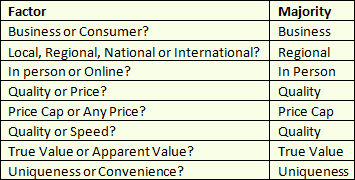You already know what you have to sell, but do you understand what your customers are buying? Do you know who they are, why they want what you have, how they make the decision to buy from you?
One of the most basic premises of marketing is matching – matching what you have to sell with customers who want buy. That means that you have to understand your customer base, and the segments within it, so you can tailor your marketing plan to find new customers like them, appeal to them, and convince them to buy from you.

Let’s look at a few basic demographics first. You can download your own worksheet here. In the first column, list your products or services. You can add up to 20, so group items together if that makes sense. For example, if you sell auto parts, you’re not going to list each individual part, so use groups like engine parts, wipers and exterior products, etc.
Then, for each item or group, put an x in the column that best represents the age groups of customers who purchase that item, and in the last column, enter an m or f to show whether more buyers are male or female. If you really have no sense of your customers’ ages or gender, best to figure out a way to find out. Could you take a guess based on names in your database? Ask your front line staff what they think? Keep track for a few weeks and estimate on that info?
Here’s an example based on our business.

The spreadsheet is set up to automatically total the number of x’s in each column. For the gender column, the result is the percentage of male buyers. So our example shows that our primary target market is men aged 36-49. What else do we know about them?
On the second tab of your spreadsheet, fill in the Majority column describing the situation for most of your clients. Here’s our example:

We know that most of our customers are businesses in Western Canada. We always have some sort of direct contact with them, as opposed to them making a purchase from our website, (as will be the case for most service suppliers).
We know that price is a factor, but we also know that they come to us for the quality of our work and the resulting outcome. They want their website or marketing plan to produce results, not just look pretty, and they want their website and marketing materials to be unique, even if it takes a bit longer to produce.
Combining the information from both tabs of the spreadsheet, we now have a pretty good picture of our target market. (we’ve basically created a customer persona) This information allows you to focus all aspects of your marketing. You’ll use it for branding purposes (coming up next month), as well as in the development of ads and in determining where those ads are best placed.
Continued:
Marketing Series Part 1 – What “Marketing” Means
Marketing Series Part 2 – Your Products, Services & Target Markets
Marketing Series Part 3 – Brand Management
Marketing Series Part 4 – Reputation Management
Marketing Series Part 5 – Customer Relations
Marketing Series Part 6 – Public Relations
Marketing Series Part 7 – Marketing Strategy
Marketing Series Part 8 – Advertising
Marketing Series Part 9 – The Components of Your Marketing Plan

